Accounting Report: One.Tel Financial Risk and Going Concern
VerifiedAdded on 2020/02/05
|10
|2782
|40
Report
AI Summary
This report provides a comprehensive analysis of accounting principles, focusing on risk assessment and the concept of going concern within the context of financial statements. It begins by identifying factors contributing to inherent risk at the financial report level and strategic business risk assessment, highlighting the importance of auditing in identifying and mitigating potential misstatements. The report then delves into the factors affecting inherent risk assessment at the balance sheet account level, emphasizing the tools and factors used to uncover hidden amounts and assess susceptibility to fraud. Finally, it explores the concept of going concern, examining the factors that influence decision-making processes related to financial planning and business operations. The report uses the case study of One.Tel, a telecommunications company, to illustrate these concepts, providing a practical application of accounting and auditing principles for financial analysis and risk management. It underscores the significance of ethical conduct, internal controls, and proper financial management in ensuring the accuracy and reliability of financial records.
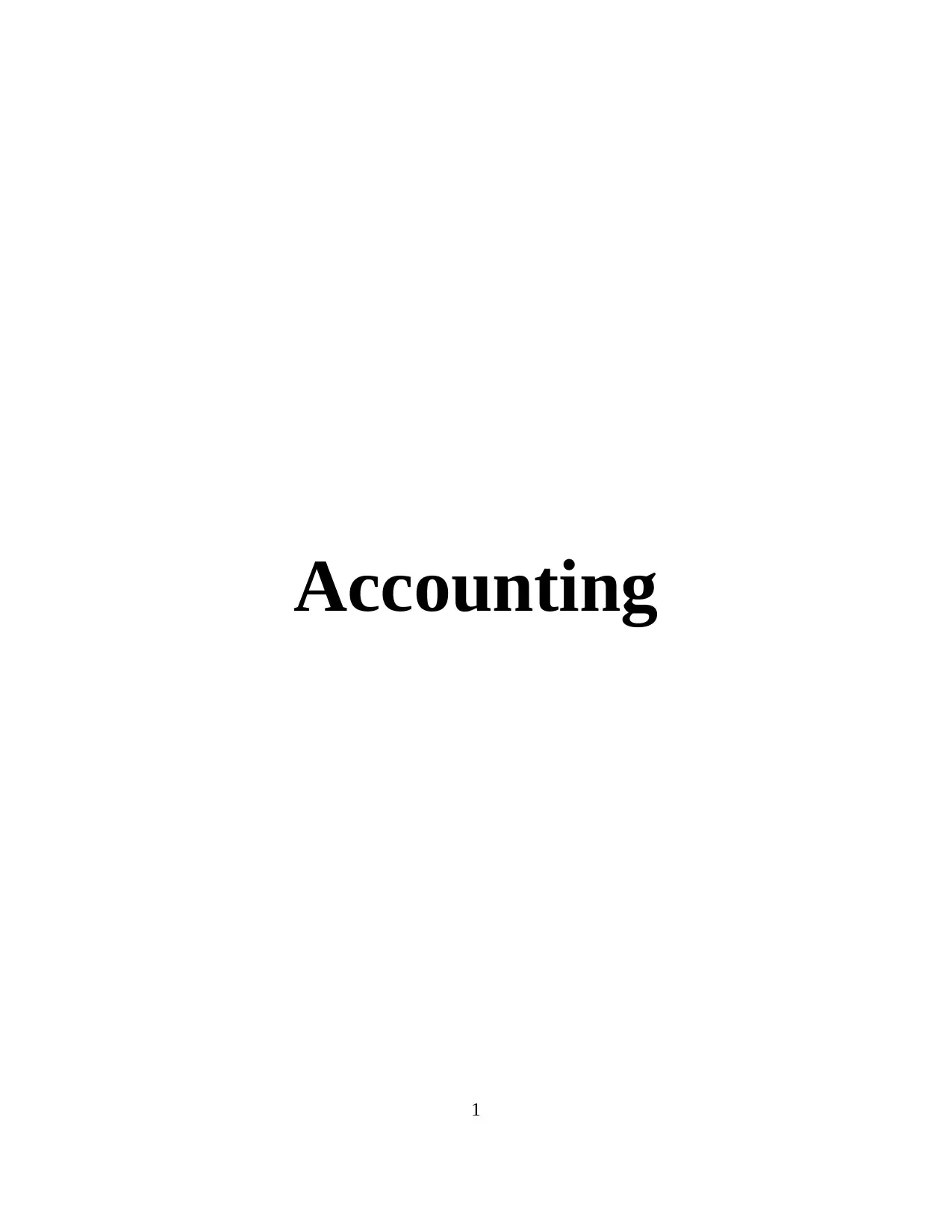
Accounting
1
1
Secure Best Marks with AI Grader
Need help grading? Try our AI Grader for instant feedback on your assignments.
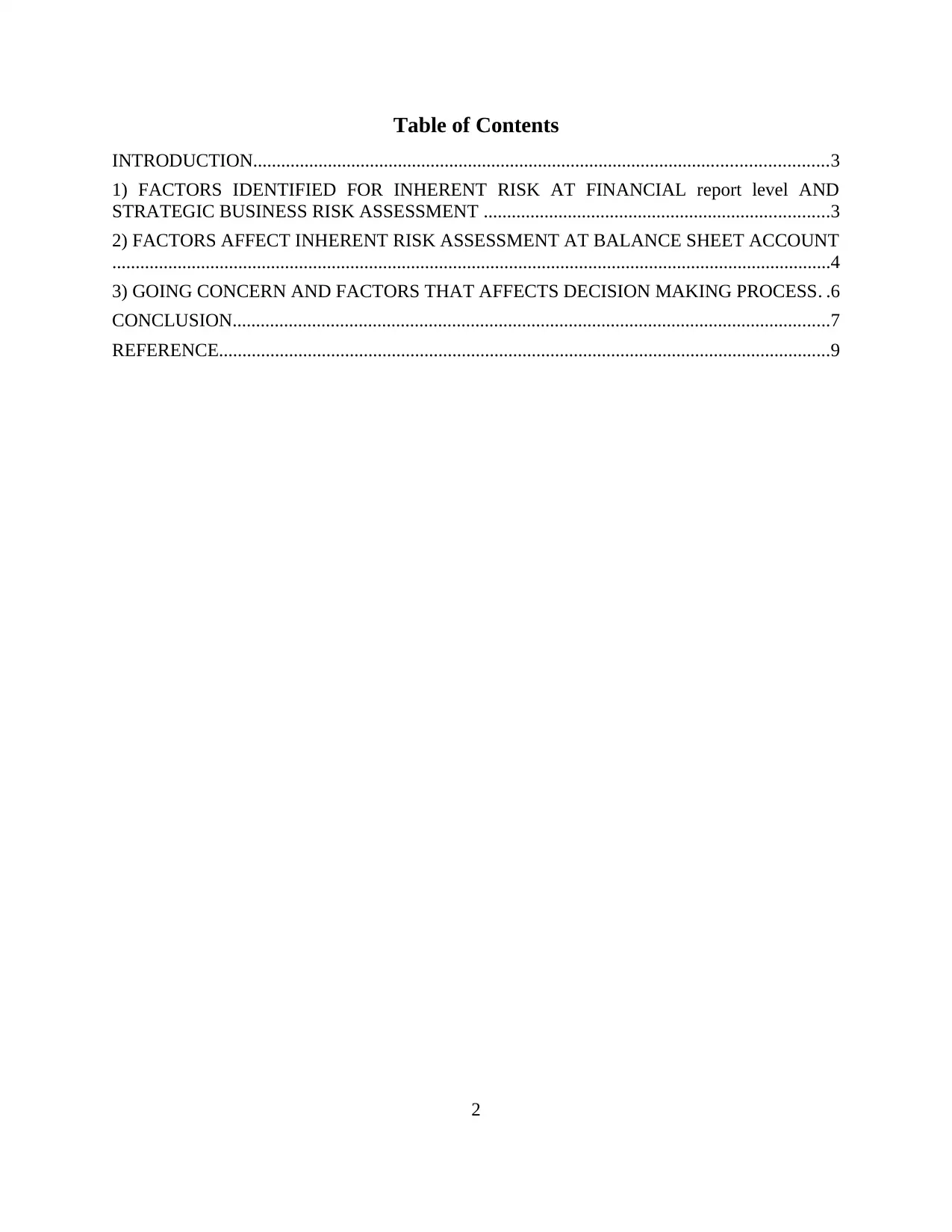
Table of Contents
INTRODUCTION...........................................................................................................................3
1) FACTORS IDENTIFIED FOR INHERENT RISK AT FINANCIAL report level AND
STRATEGIC BUSINESS RISK ASSESSMENT ..........................................................................3
2) FACTORS AFFECT INHERENT RISK ASSESSMENT AT BALANCE SHEET ACCOUNT
..........................................................................................................................................................4
3) GOING CONCERN AND FACTORS THAT AFFECTS DECISION MAKING PROCESS. .6
CONCLUSION................................................................................................................................7
REFERENCE...................................................................................................................................9
2
INTRODUCTION...........................................................................................................................3
1) FACTORS IDENTIFIED FOR INHERENT RISK AT FINANCIAL report level AND
STRATEGIC BUSINESS RISK ASSESSMENT ..........................................................................3
2) FACTORS AFFECT INHERENT RISK ASSESSMENT AT BALANCE SHEET ACCOUNT
..........................................................................................................................................................4
3) GOING CONCERN AND FACTORS THAT AFFECTS DECISION MAKING PROCESS. .6
CONCLUSION................................................................................................................................7
REFERENCE...................................................................................................................................9
2
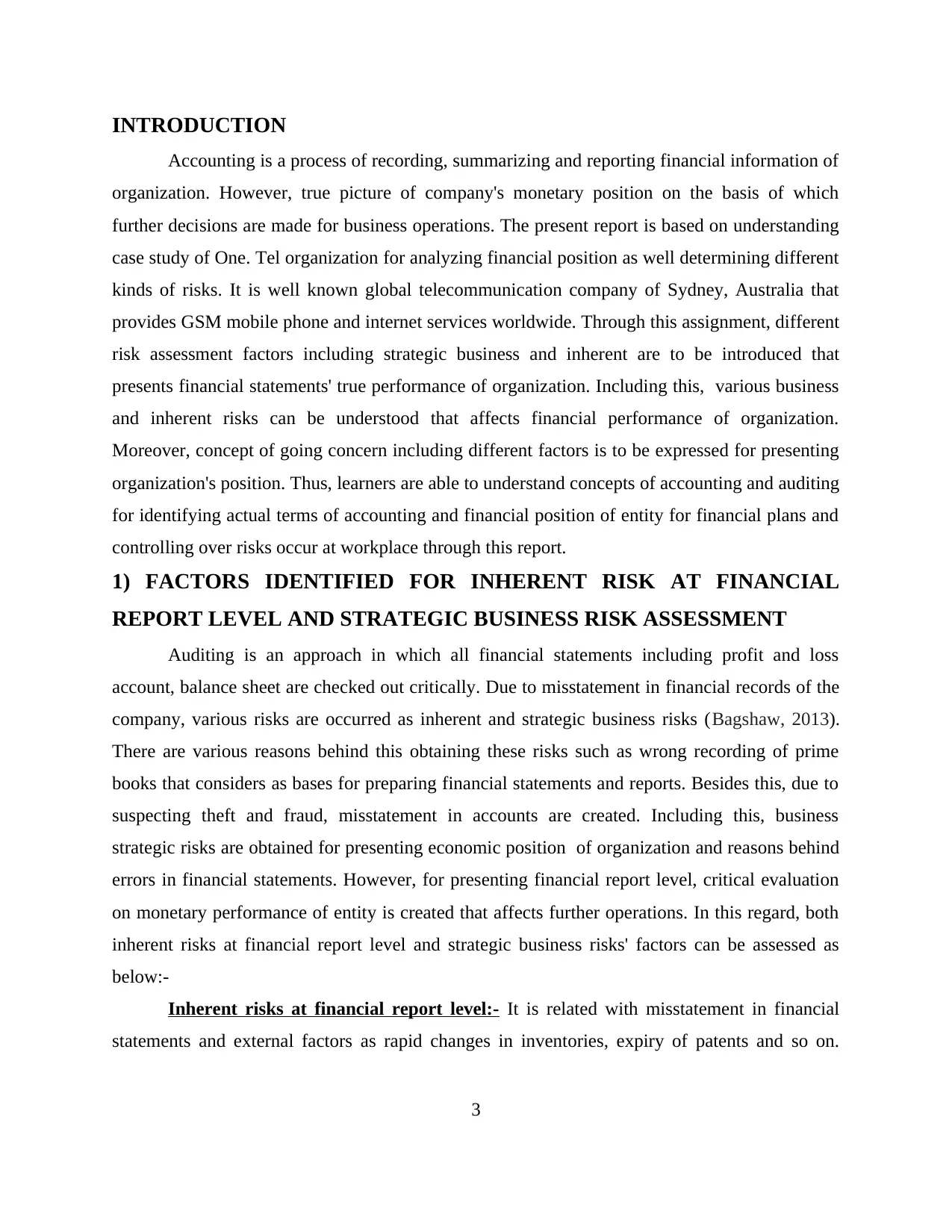
INTRODUCTION
Accounting is a process of recording, summarizing and reporting financial information of
organization. However, true picture of company's monetary position on the basis of which
further decisions are made for business operations. The present report is based on understanding
case study of One. Tel organization for analyzing financial position as well determining different
kinds of risks. It is well known global telecommunication company of Sydney, Australia that
provides GSM mobile phone and internet services worldwide. Through this assignment, different
risk assessment factors including strategic business and inherent are to be introduced that
presents financial statements' true performance of organization. Including this, various business
and inherent risks can be understood that affects financial performance of organization.
Moreover, concept of going concern including different factors is to be expressed for presenting
organization's position. Thus, learners are able to understand concepts of accounting and auditing
for identifying actual terms of accounting and financial position of entity for financial plans and
controlling over risks occur at workplace through this report.
1) FACTORS IDENTIFIED FOR INHERENT RISK AT FINANCIAL
REPORT LEVEL AND STRATEGIC BUSINESS RISK ASSESSMENT
Auditing is an approach in which all financial statements including profit and loss
account, balance sheet are checked out critically. Due to misstatement in financial records of the
company, various risks are occurred as inherent and strategic business risks (Bagshaw, 2013).
There are various reasons behind this obtaining these risks such as wrong recording of prime
books that considers as bases for preparing financial statements and reports. Besides this, due to
suspecting theft and fraud, misstatement in accounts are created. Including this, business
strategic risks are obtained for presenting economic position of organization and reasons behind
errors in financial statements. However, for presenting financial report level, critical evaluation
on monetary performance of entity is created that affects further operations. In this regard, both
inherent risks at financial report level and strategic business risks' factors can be assessed as
below:-
Inherent risks at financial report level:- It is related with misstatement in financial
statements and external factors as rapid changes in inventories, expiry of patents and so on.
3
Accounting is a process of recording, summarizing and reporting financial information of
organization. However, true picture of company's monetary position on the basis of which
further decisions are made for business operations. The present report is based on understanding
case study of One. Tel organization for analyzing financial position as well determining different
kinds of risks. It is well known global telecommunication company of Sydney, Australia that
provides GSM mobile phone and internet services worldwide. Through this assignment, different
risk assessment factors including strategic business and inherent are to be introduced that
presents financial statements' true performance of organization. Including this, various business
and inherent risks can be understood that affects financial performance of organization.
Moreover, concept of going concern including different factors is to be expressed for presenting
organization's position. Thus, learners are able to understand concepts of accounting and auditing
for identifying actual terms of accounting and financial position of entity for financial plans and
controlling over risks occur at workplace through this report.
1) FACTORS IDENTIFIED FOR INHERENT RISK AT FINANCIAL
REPORT LEVEL AND STRATEGIC BUSINESS RISK ASSESSMENT
Auditing is an approach in which all financial statements including profit and loss
account, balance sheet are checked out critically. Due to misstatement in financial records of the
company, various risks are occurred as inherent and strategic business risks (Bagshaw, 2013).
There are various reasons behind this obtaining these risks such as wrong recording of prime
books that considers as bases for preparing financial statements and reports. Besides this, due to
suspecting theft and fraud, misstatement in accounts are created. Including this, business
strategic risks are obtained for presenting economic position of organization and reasons behind
errors in financial statements. However, for presenting financial report level, critical evaluation
on monetary performance of entity is created that affects further operations. In this regard, both
inherent risks at financial report level and strategic business risks' factors can be assessed as
below:-
Inherent risks at financial report level:- It is related with misstatement in financial
statements and external factors as rapid changes in inventories, expiry of patents and so on.
3
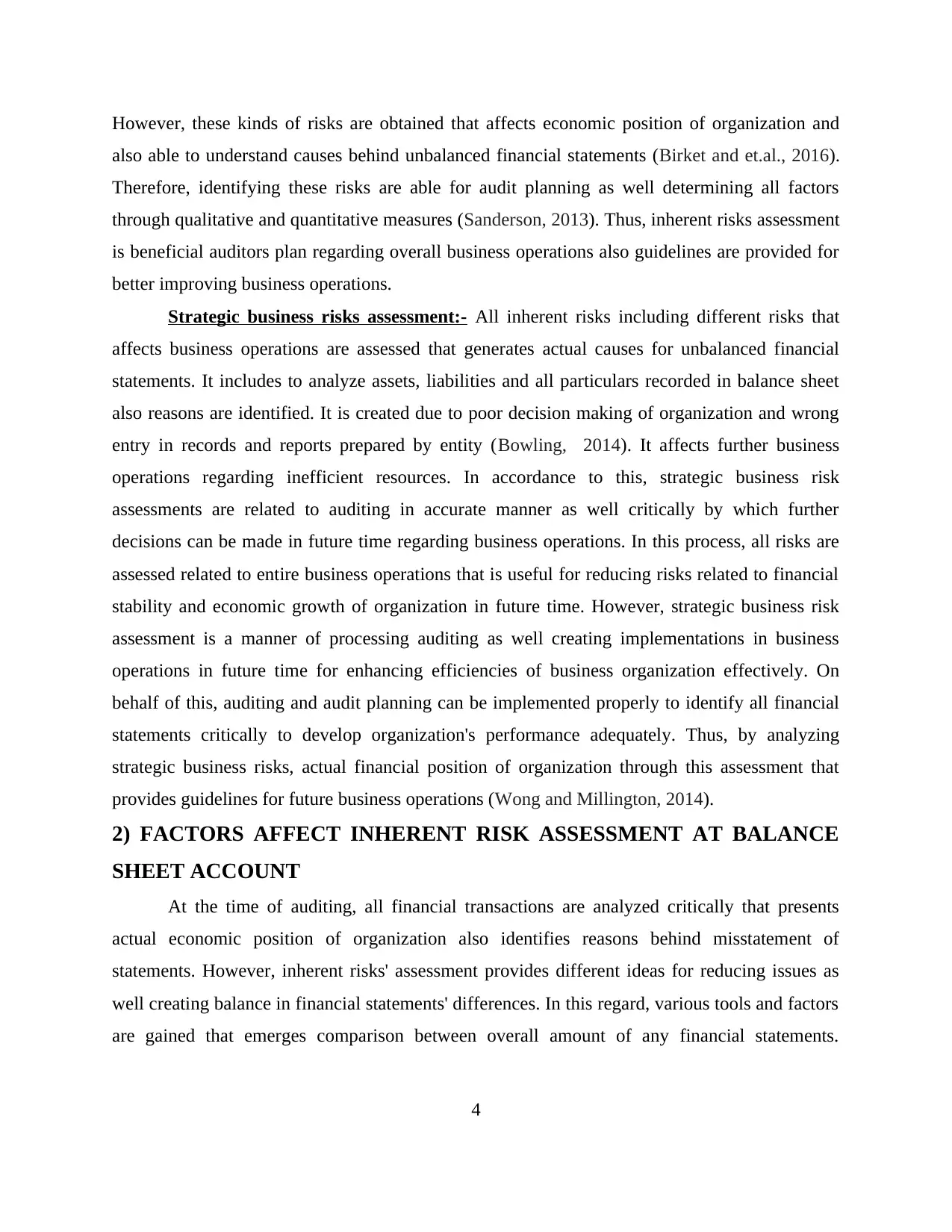
However, these kinds of risks are obtained that affects economic position of organization and
also able to understand causes behind unbalanced financial statements (Birket and et.al., 2016).
Therefore, identifying these risks are able for audit planning as well determining all factors
through qualitative and quantitative measures (Sanderson, 2013). Thus, inherent risks assessment
is beneficial auditors plan regarding overall business operations also guidelines are provided for
better improving business operations.
Strategic business risks assessment:- All inherent risks including different risks that
affects business operations are assessed that generates actual causes for unbalanced financial
statements. It includes to analyze assets, liabilities and all particulars recorded in balance sheet
also reasons are identified. It is created due to poor decision making of organization and wrong
entry in records and reports prepared by entity (Bowling, 2014). It affects further business
operations regarding inefficient resources. In accordance to this, strategic business risk
assessments are related to auditing in accurate manner as well critically by which further
decisions can be made in future time regarding business operations. In this process, all risks are
assessed related to entire business operations that is useful for reducing risks related to financial
stability and economic growth of organization in future time. However, strategic business risk
assessment is a manner of processing auditing as well creating implementations in business
operations in future time for enhancing efficiencies of business organization effectively. On
behalf of this, auditing and audit planning can be implemented properly to identify all financial
statements critically to develop organization's performance adequately. Thus, by analyzing
strategic business risks, actual financial position of organization through this assessment that
provides guidelines for future business operations (Wong and Millington, 2014).
2) FACTORS AFFECT INHERENT RISK ASSESSMENT AT BALANCE
SHEET ACCOUNT
At the time of auditing, all financial transactions are analyzed critically that presents
actual economic position of organization also identifies reasons behind misstatement of
statements. However, inherent risks' assessment provides different ideas for reducing issues as
well creating balance in financial statements' differences. In this regard, various tools and factors
are gained that emerges comparison between overall amount of any financial statements.
4
also able to understand causes behind unbalanced financial statements (Birket and et.al., 2016).
Therefore, identifying these risks are able for audit planning as well determining all factors
through qualitative and quantitative measures (Sanderson, 2013). Thus, inherent risks assessment
is beneficial auditors plan regarding overall business operations also guidelines are provided for
better improving business operations.
Strategic business risks assessment:- All inherent risks including different risks that
affects business operations are assessed that generates actual causes for unbalanced financial
statements. It includes to analyze assets, liabilities and all particulars recorded in balance sheet
also reasons are identified. It is created due to poor decision making of organization and wrong
entry in records and reports prepared by entity (Bowling, 2014). It affects further business
operations regarding inefficient resources. In accordance to this, strategic business risk
assessments are related to auditing in accurate manner as well critically by which further
decisions can be made in future time regarding business operations. In this process, all risks are
assessed related to entire business operations that is useful for reducing risks related to financial
stability and economic growth of organization in future time. However, strategic business risk
assessment is a manner of processing auditing as well creating implementations in business
operations in future time for enhancing efficiencies of business organization effectively. On
behalf of this, auditing and audit planning can be implemented properly to identify all financial
statements critically to develop organization's performance adequately. Thus, by analyzing
strategic business risks, actual financial position of organization through this assessment that
provides guidelines for future business operations (Wong and Millington, 2014).
2) FACTORS AFFECT INHERENT RISK ASSESSMENT AT BALANCE
SHEET ACCOUNT
At the time of auditing, all financial transactions are analyzed critically that presents
actual economic position of organization also identifies reasons behind misstatement of
statements. However, inherent risks' assessment provides different ideas for reducing issues as
well creating balance in financial statements' differences. In this regard, various tools and factors
are gained that emerges comparison between overall amount of any financial statements.
4
Secure Best Marks with AI Grader
Need help grading? Try our AI Grader for instant feedback on your assignments.
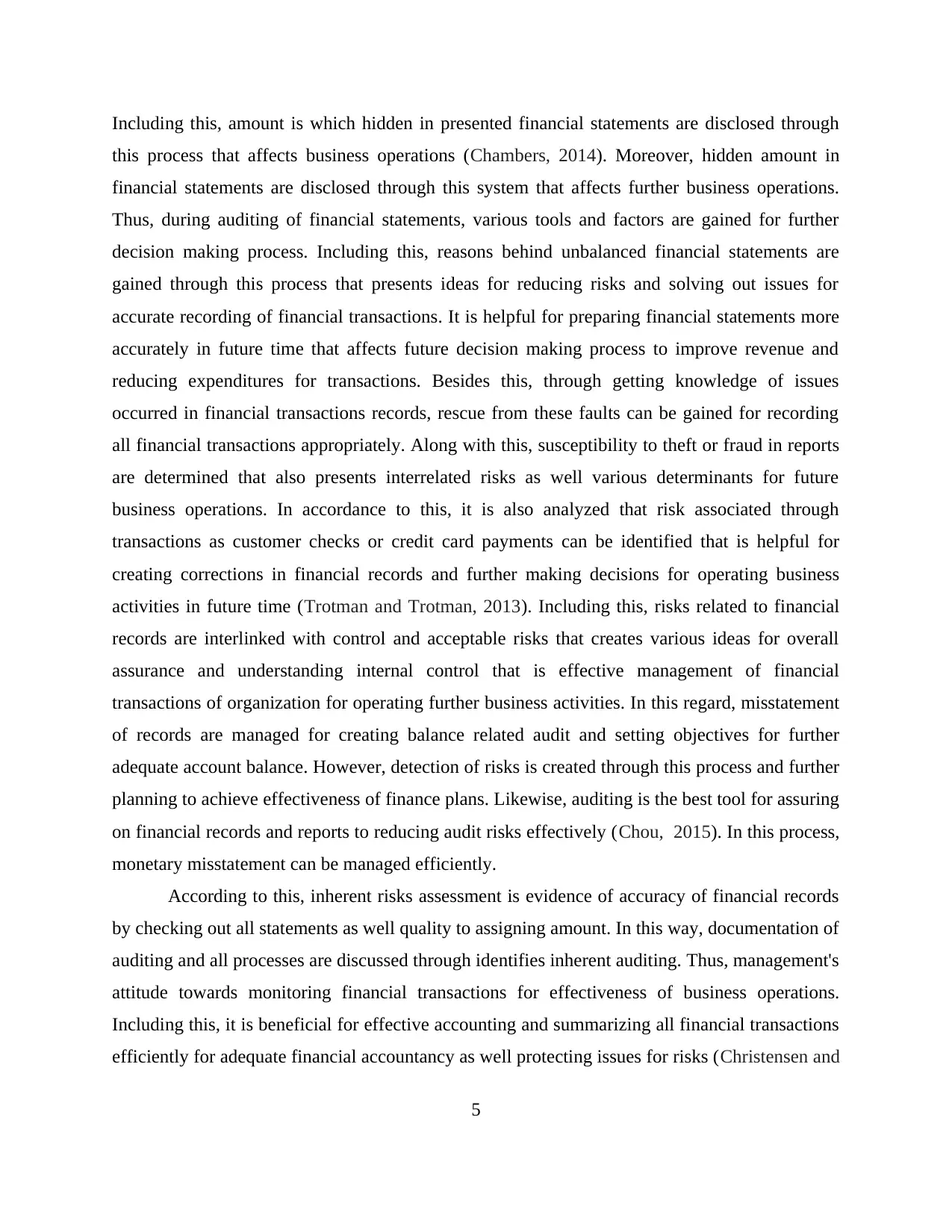
Including this, amount is which hidden in presented financial statements are disclosed through
this process that affects business operations (Chambers, 2014). Moreover, hidden amount in
financial statements are disclosed through this system that affects further business operations.
Thus, during auditing of financial statements, various tools and factors are gained for further
decision making process. Including this, reasons behind unbalanced financial statements are
gained through this process that presents ideas for reducing risks and solving out issues for
accurate recording of financial transactions. It is helpful for preparing financial statements more
accurately in future time that affects future decision making process to improve revenue and
reducing expenditures for transactions. Besides this, through getting knowledge of issues
occurred in financial transactions records, rescue from these faults can be gained for recording
all financial transactions appropriately. Along with this, susceptibility to theft or fraud in reports
are determined that also presents interrelated risks as well various determinants for future
business operations. In accordance to this, it is also analyzed that risk associated through
transactions as customer checks or credit card payments can be identified that is helpful for
creating corrections in financial records and further making decisions for operating business
activities in future time (Trotman and Trotman, 2013). Including this, risks related to financial
records are interlinked with control and acceptable risks that creates various ideas for overall
assurance and understanding internal control that is effective management of financial
transactions of organization for operating further business activities. In this regard, misstatement
of records are managed for creating balance related audit and setting objectives for further
adequate account balance. However, detection of risks is created through this process and further
planning to achieve effectiveness of finance plans. Likewise, auditing is the best tool for assuring
on financial records and reports to reducing audit risks effectively (Chou, 2015). In this process,
monetary misstatement can be managed efficiently.
According to this, inherent risks assessment is evidence of accuracy of financial records
by checking out all statements as well quality to assigning amount. In this way, documentation of
auditing and all processes are discussed through identifies inherent auditing. Thus, management's
attitude towards monitoring financial transactions for effectiveness of business operations.
Including this, it is beneficial for effective accounting and summarizing all financial transactions
efficiently for adequate financial accountancy as well protecting issues for risks (Christensen and
5
this process that affects business operations (Chambers, 2014). Moreover, hidden amount in
financial statements are disclosed through this system that affects further business operations.
Thus, during auditing of financial statements, various tools and factors are gained for further
decision making process. Including this, reasons behind unbalanced financial statements are
gained through this process that presents ideas for reducing risks and solving out issues for
accurate recording of financial transactions. It is helpful for preparing financial statements more
accurately in future time that affects future decision making process to improve revenue and
reducing expenditures for transactions. Besides this, through getting knowledge of issues
occurred in financial transactions records, rescue from these faults can be gained for recording
all financial transactions appropriately. Along with this, susceptibility to theft or fraud in reports
are determined that also presents interrelated risks as well various determinants for future
business operations. In accordance to this, it is also analyzed that risk associated through
transactions as customer checks or credit card payments can be identified that is helpful for
creating corrections in financial records and further making decisions for operating business
activities in future time (Trotman and Trotman, 2013). Including this, risks related to financial
records are interlinked with control and acceptable risks that creates various ideas for overall
assurance and understanding internal control that is effective management of financial
transactions of organization for operating further business activities. In this regard, misstatement
of records are managed for creating balance related audit and setting objectives for further
adequate account balance. However, detection of risks is created through this process and further
planning to achieve effectiveness of finance plans. Likewise, auditing is the best tool for assuring
on financial records and reports to reducing audit risks effectively (Chou, 2015). In this process,
monetary misstatement can be managed efficiently.
According to this, inherent risks assessment is evidence of accuracy of financial records
by checking out all statements as well quality to assigning amount. In this way, documentation of
auditing and all processes are discussed through identifies inherent auditing. Thus, management's
attitude towards monitoring financial transactions for effectiveness of business operations.
Including this, it is beneficial for effective accounting and summarizing all financial transactions
efficiently for adequate financial accountancy as well protecting issues for risks (Christensen and
5
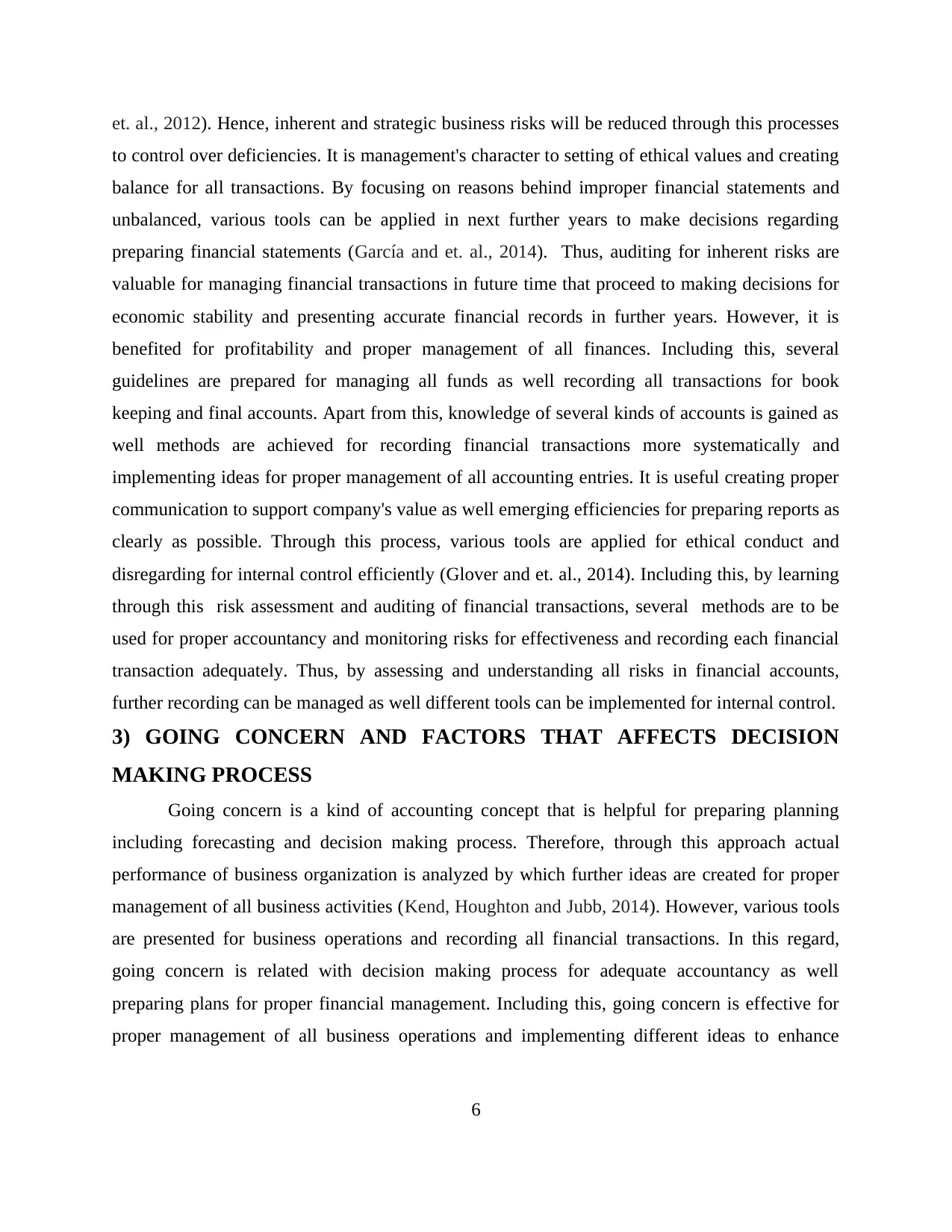
et. al., 2012). Hence, inherent and strategic business risks will be reduced through this processes
to control over deficiencies. It is management's character to setting of ethical values and creating
balance for all transactions. By focusing on reasons behind improper financial statements and
unbalanced, various tools can be applied in next further years to make decisions regarding
preparing financial statements (García and et. al., 2014). Thus, auditing for inherent risks are
valuable for managing financial transactions in future time that proceed to making decisions for
economic stability and presenting accurate financial records in further years. However, it is
benefited for profitability and proper management of all finances. Including this, several
guidelines are prepared for managing all funds as well recording all transactions for book
keeping and final accounts. Apart from this, knowledge of several kinds of accounts is gained as
well methods are achieved for recording financial transactions more systematically and
implementing ideas for proper management of all accounting entries. It is useful creating proper
communication to support company's value as well emerging efficiencies for preparing reports as
clearly as possible. Through this process, various tools are applied for ethical conduct and
disregarding for internal control efficiently (Glover and et. al., 2014). Including this, by learning
through this risk assessment and auditing of financial transactions, several methods are to be
used for proper accountancy and monitoring risks for effectiveness and recording each financial
transaction adequately. Thus, by assessing and understanding all risks in financial accounts,
further recording can be managed as well different tools can be implemented for internal control.
3) GOING CONCERN AND FACTORS THAT AFFECTS DECISION
MAKING PROCESS
Going concern is a kind of accounting concept that is helpful for preparing planning
including forecasting and decision making process. Therefore, through this approach actual
performance of business organization is analyzed by which further ideas are created for proper
management of all business activities (Kend, Houghton and Jubb, 2014). However, various tools
are presented for business operations and recording all financial transactions. In this regard,
going concern is related with decision making process for adequate accountancy as well
preparing plans for proper financial management. Including this, going concern is effective for
proper management of all business operations and implementing different ideas to enhance
6
to control over deficiencies. It is management's character to setting of ethical values and creating
balance for all transactions. By focusing on reasons behind improper financial statements and
unbalanced, various tools can be applied in next further years to make decisions regarding
preparing financial statements (García and et. al., 2014). Thus, auditing for inherent risks are
valuable for managing financial transactions in future time that proceed to making decisions for
economic stability and presenting accurate financial records in further years. However, it is
benefited for profitability and proper management of all finances. Including this, several
guidelines are prepared for managing all funds as well recording all transactions for book
keeping and final accounts. Apart from this, knowledge of several kinds of accounts is gained as
well methods are achieved for recording financial transactions more systematically and
implementing ideas for proper management of all accounting entries. It is useful creating proper
communication to support company's value as well emerging efficiencies for preparing reports as
clearly as possible. Through this process, various tools are applied for ethical conduct and
disregarding for internal control efficiently (Glover and et. al., 2014). Including this, by learning
through this risk assessment and auditing of financial transactions, several methods are to be
used for proper accountancy and monitoring risks for effectiveness and recording each financial
transaction adequately. Thus, by assessing and understanding all risks in financial accounts,
further recording can be managed as well different tools can be implemented for internal control.
3) GOING CONCERN AND FACTORS THAT AFFECTS DECISION
MAKING PROCESS
Going concern is a kind of accounting concept that is helpful for preparing planning
including forecasting and decision making process. Therefore, through this approach actual
performance of business organization is analyzed by which further ideas are created for proper
management of all business activities (Kend, Houghton and Jubb, 2014). However, various tools
are presented for business operations and recording all financial transactions. In this regard,
going concern is related with decision making process for adequate accountancy as well
preparing plans for proper financial management. Including this, going concern is effective for
proper management of all business operations and implementing different ideas to enhance
6
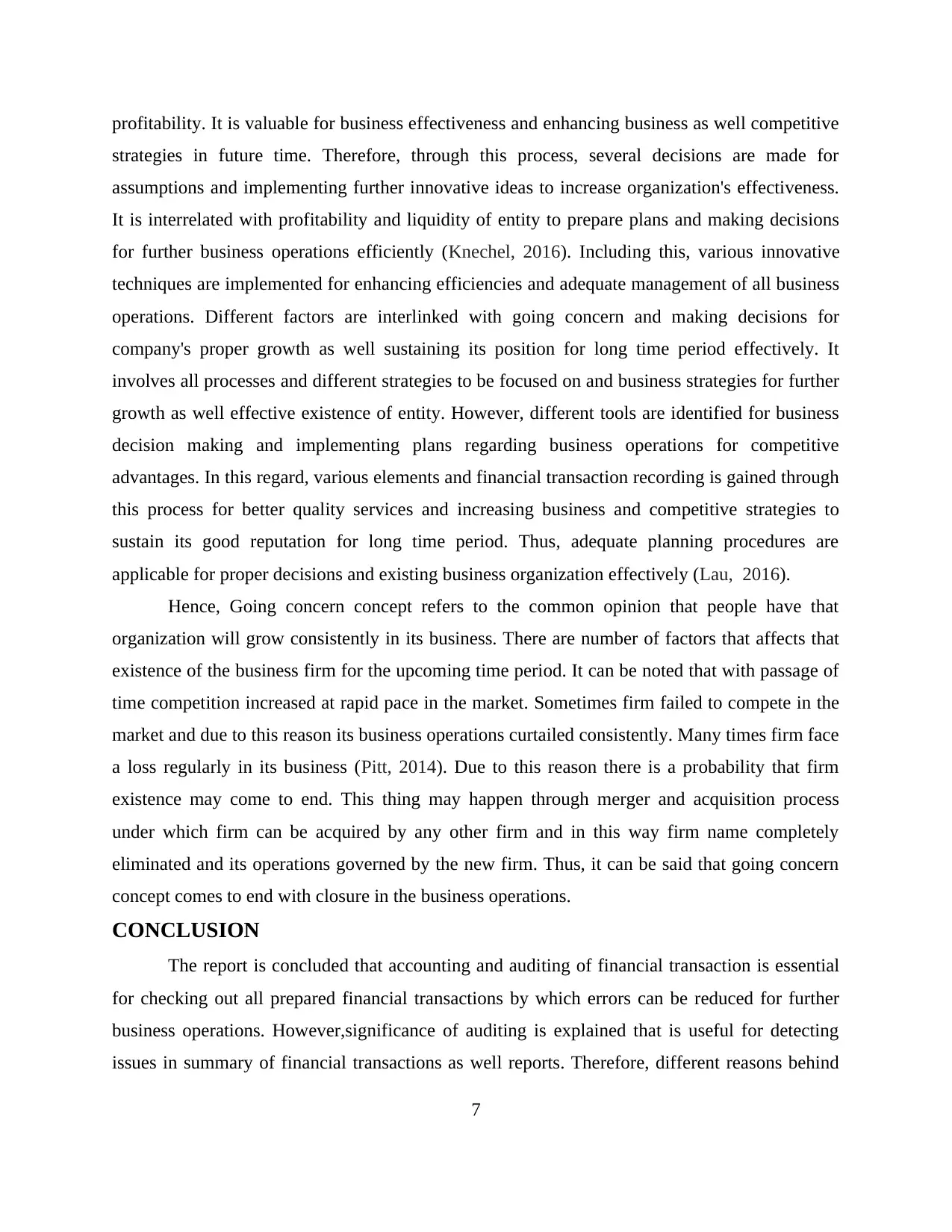
profitability. It is valuable for business effectiveness and enhancing business as well competitive
strategies in future time. Therefore, through this process, several decisions are made for
assumptions and implementing further innovative ideas to increase organization's effectiveness.
It is interrelated with profitability and liquidity of entity to prepare plans and making decisions
for further business operations efficiently (Knechel, 2016). Including this, various innovative
techniques are implemented for enhancing efficiencies and adequate management of all business
operations. Different factors are interlinked with going concern and making decisions for
company's proper growth as well sustaining its position for long time period effectively. It
involves all processes and different strategies to be focused on and business strategies for further
growth as well effective existence of entity. However, different tools are identified for business
decision making and implementing plans regarding business operations for competitive
advantages. In this regard, various elements and financial transaction recording is gained through
this process for better quality services and increasing business and competitive strategies to
sustain its good reputation for long time period. Thus, adequate planning procedures are
applicable for proper decisions and existing business organization effectively (Lau, 2016).
Hence, Going concern concept refers to the common opinion that people have that
organization will grow consistently in its business. There are number of factors that affects that
existence of the business firm for the upcoming time period. It can be noted that with passage of
time competition increased at rapid pace in the market. Sometimes firm failed to compete in the
market and due to this reason its business operations curtailed consistently. Many times firm face
a loss regularly in its business (Pitt, 2014). Due to this reason there is a probability that firm
existence may come to end. This thing may happen through merger and acquisition process
under which firm can be acquired by any other firm and in this way firm name completely
eliminated and its operations governed by the new firm. Thus, it can be said that going concern
concept comes to end with closure in the business operations.
CONCLUSION
The report is concluded that accounting and auditing of financial transaction is essential
for checking out all prepared financial transactions by which errors can be reduced for further
business operations. However,significance of auditing is explained that is useful for detecting
issues in summary of financial transactions as well reports. Therefore, different reasons behind
7
strategies in future time. Therefore, through this process, several decisions are made for
assumptions and implementing further innovative ideas to increase organization's effectiveness.
It is interrelated with profitability and liquidity of entity to prepare plans and making decisions
for further business operations efficiently (Knechel, 2016). Including this, various innovative
techniques are implemented for enhancing efficiencies and adequate management of all business
operations. Different factors are interlinked with going concern and making decisions for
company's proper growth as well sustaining its position for long time period effectively. It
involves all processes and different strategies to be focused on and business strategies for further
growth as well effective existence of entity. However, different tools are identified for business
decision making and implementing plans regarding business operations for competitive
advantages. In this regard, various elements and financial transaction recording is gained through
this process for better quality services and increasing business and competitive strategies to
sustain its good reputation for long time period. Thus, adequate planning procedures are
applicable for proper decisions and existing business organization effectively (Lau, 2016).
Hence, Going concern concept refers to the common opinion that people have that
organization will grow consistently in its business. There are number of factors that affects that
existence of the business firm for the upcoming time period. It can be noted that with passage of
time competition increased at rapid pace in the market. Sometimes firm failed to compete in the
market and due to this reason its business operations curtailed consistently. Many times firm face
a loss regularly in its business (Pitt, 2014). Due to this reason there is a probability that firm
existence may come to end. This thing may happen through merger and acquisition process
under which firm can be acquired by any other firm and in this way firm name completely
eliminated and its operations governed by the new firm. Thus, it can be said that going concern
concept comes to end with closure in the business operations.
CONCLUSION
The report is concluded that accounting and auditing of financial transaction is essential
for checking out all prepared financial transactions by which errors can be reduced for further
business operations. However,significance of auditing is explained that is useful for detecting
issues in summary of financial transactions as well reports. Therefore, different reasons behind
7
Paraphrase This Document
Need a fresh take? Get an instant paraphrase of this document with our AI Paraphraser
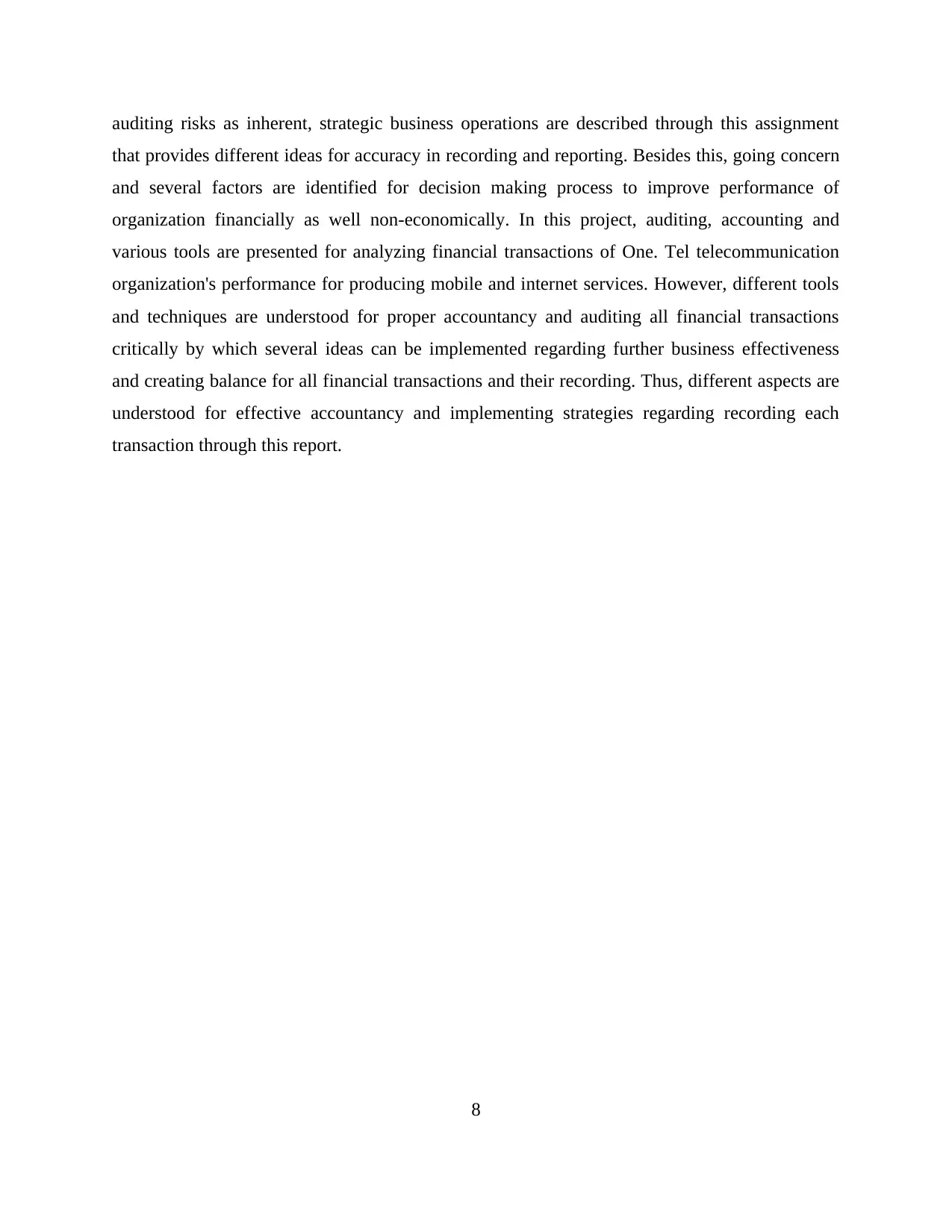
auditing risks as inherent, strategic business operations are described through this assignment
that provides different ideas for accuracy in recording and reporting. Besides this, going concern
and several factors are identified for decision making process to improve performance of
organization financially as well non-economically. In this project, auditing, accounting and
various tools are presented for analyzing financial transactions of One. Tel telecommunication
organization's performance for producing mobile and internet services. However, different tools
and techniques are understood for proper accountancy and auditing all financial transactions
critically by which several ideas can be implemented regarding further business effectiveness
and creating balance for all financial transactions and their recording. Thus, different aspects are
understood for effective accountancy and implementing strategies regarding recording each
transaction through this report.
8
that provides different ideas for accuracy in recording and reporting. Besides this, going concern
and several factors are identified for decision making process to improve performance of
organization financially as well non-economically. In this project, auditing, accounting and
various tools are presented for analyzing financial transactions of One. Tel telecommunication
organization's performance for producing mobile and internet services. However, different tools
and techniques are understood for proper accountancy and auditing all financial transactions
critically by which several ideas can be implemented regarding further business effectiveness
and creating balance for all financial transactions and their recording. Thus, different aspects are
understood for effective accountancy and implementing strategies regarding recording each
transaction through this report.
8
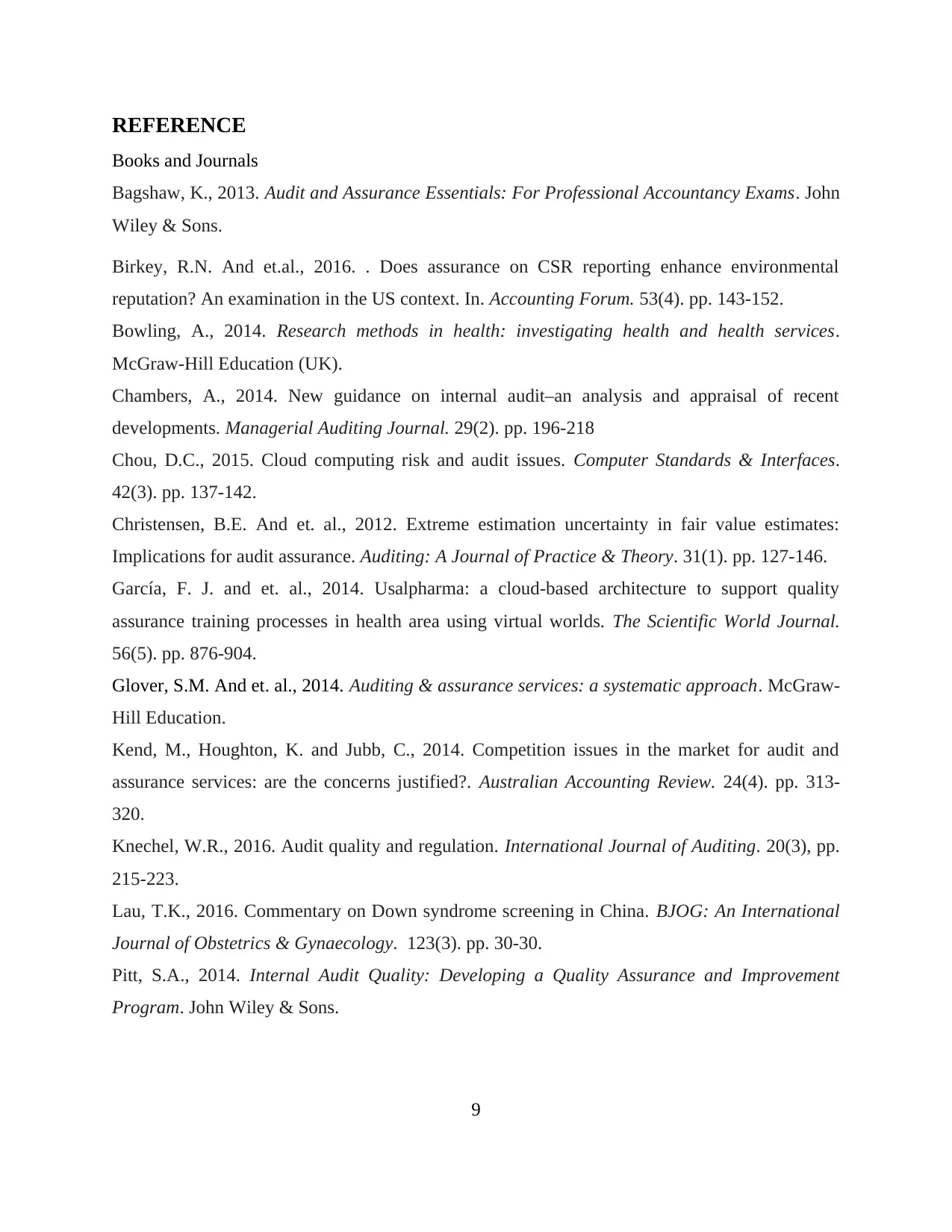
REFERENCE
Books and Journals
Bagshaw, K., 2013. Audit and Assurance Essentials: For Professional Accountancy Exams. John
Wiley & Sons.
Birkey, R.N. And et.al., 2016. . Does assurance on CSR reporting enhance environmental
reputation? An examination in the US context. In. Accounting Forum. 53(4). pp. 143-152.
Bowling, A., 2014. Research methods in health: investigating health and health services.
McGraw-Hill Education (UK).
Chambers, A., 2014. New guidance on internal audit–an analysis and appraisal of recent
developments. Managerial Auditing Journal. 29(2). pp. 196-218
Chou, D.C., 2015. Cloud computing risk and audit issues. Computer Standards & Interfaces.
42(3). pp. 137-142.
Christensen, B.E. And et. al., 2012. Extreme estimation uncertainty in fair value estimates:
Implications for audit assurance. Auditing: A Journal of Practice & Theory. 31(1). pp. 127-146.
García, F. J. and et. al., 2014. Usalpharma: a cloud-based architecture to support quality
assurance training processes in health area using virtual worlds. The Scientific World Journal.
56(5). pp. 876-904.
Glover, S.M. And et. al., 2014. Auditing & assurance services: a systematic approach. McGraw-
Hill Education.
Kend, M., Houghton, K. and Jubb, C., 2014. Competition issues in the market for audit and
assurance services: are the concerns justified?. Australian Accounting Review. 24(4). pp. 313-
320.
Knechel, W.R., 2016. Audit quality and regulation. International Journal of Auditing. 20(3), pp.
215-223.
Lau, T.K., 2016. Commentary on Down syndrome screening in China. BJOG: An International
Journal of Obstetrics & Gynaecology. 123(3). pp. 30-30.
Pitt, S.A., 2014. Internal Audit Quality: Developing a Quality Assurance and Improvement
Program. John Wiley & Sons.
9
Books and Journals
Bagshaw, K., 2013. Audit and Assurance Essentials: For Professional Accountancy Exams. John
Wiley & Sons.
Birkey, R.N. And et.al., 2016. . Does assurance on CSR reporting enhance environmental
reputation? An examination in the US context. In. Accounting Forum. 53(4). pp. 143-152.
Bowling, A., 2014. Research methods in health: investigating health and health services.
McGraw-Hill Education (UK).
Chambers, A., 2014. New guidance on internal audit–an analysis and appraisal of recent
developments. Managerial Auditing Journal. 29(2). pp. 196-218
Chou, D.C., 2015. Cloud computing risk and audit issues. Computer Standards & Interfaces.
42(3). pp. 137-142.
Christensen, B.E. And et. al., 2012. Extreme estimation uncertainty in fair value estimates:
Implications for audit assurance. Auditing: A Journal of Practice & Theory. 31(1). pp. 127-146.
García, F. J. and et. al., 2014. Usalpharma: a cloud-based architecture to support quality
assurance training processes in health area using virtual worlds. The Scientific World Journal.
56(5). pp. 876-904.
Glover, S.M. And et. al., 2014. Auditing & assurance services: a systematic approach. McGraw-
Hill Education.
Kend, M., Houghton, K. and Jubb, C., 2014. Competition issues in the market for audit and
assurance services: are the concerns justified?. Australian Accounting Review. 24(4). pp. 313-
320.
Knechel, W.R., 2016. Audit quality and regulation. International Journal of Auditing. 20(3), pp.
215-223.
Lau, T.K., 2016. Commentary on Down syndrome screening in China. BJOG: An International
Journal of Obstetrics & Gynaecology. 123(3). pp. 30-30.
Pitt, S.A., 2014. Internal Audit Quality: Developing a Quality Assurance and Improvement
Program. John Wiley & Sons.
9
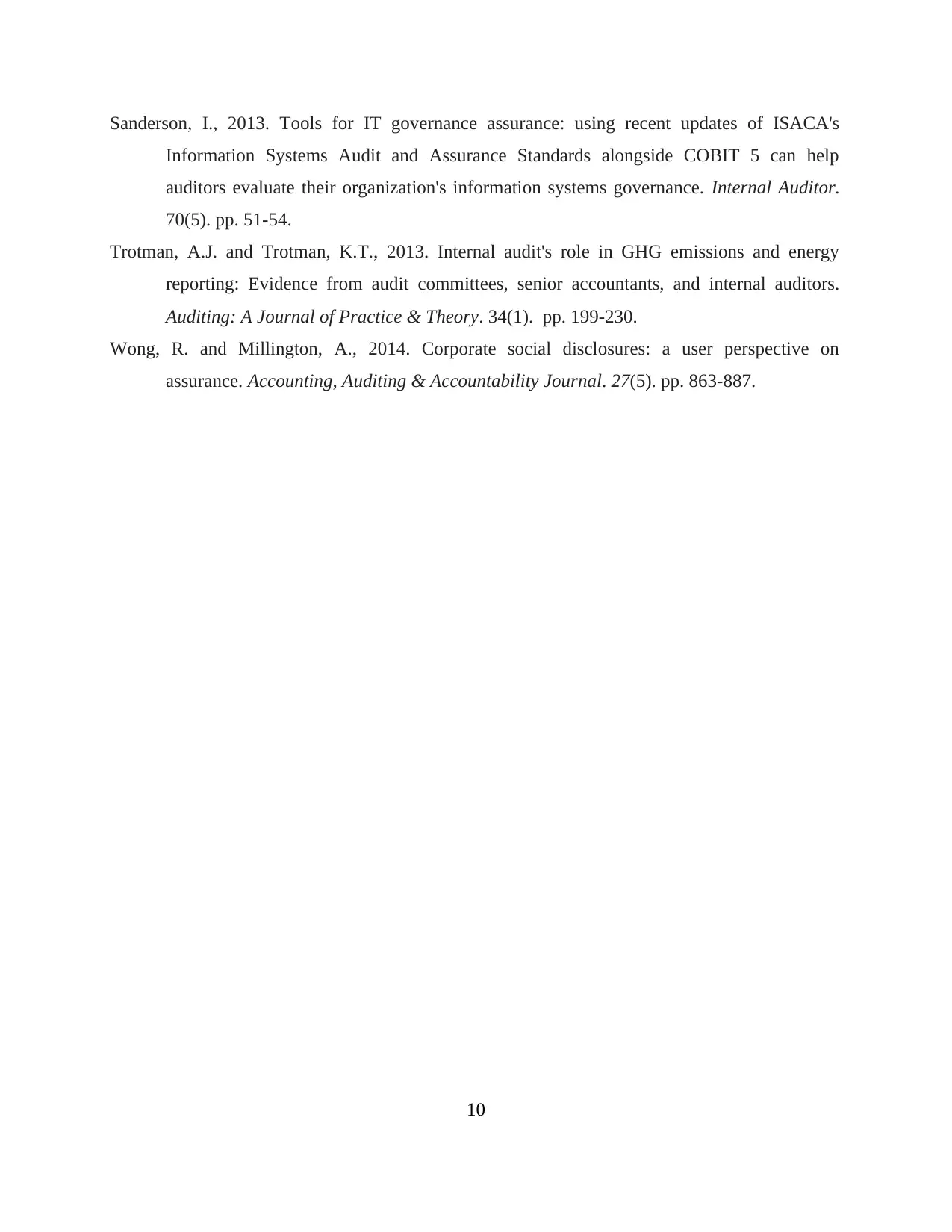
Sanderson, I., 2013. Tools for IT governance assurance: using recent updates of ISACA's
Information Systems Audit and Assurance Standards alongside COBIT 5 can help
auditors evaluate their organization's information systems governance. Internal Auditor.
70(5). pp. 51-54.
Trotman, A.J. and Trotman, K.T., 2013. Internal audit's role in GHG emissions and energy
reporting: Evidence from audit committees, senior accountants, and internal auditors.
Auditing: A Journal of Practice & Theory. 34(1). pp. 199-230.
Wong, R. and Millington, A., 2014. Corporate social disclosures: a user perspective on
assurance. Accounting, Auditing & Accountability Journal. 27(5). pp. 863-887.
10
Information Systems Audit and Assurance Standards alongside COBIT 5 can help
auditors evaluate their organization's information systems governance. Internal Auditor.
70(5). pp. 51-54.
Trotman, A.J. and Trotman, K.T., 2013. Internal audit's role in GHG emissions and energy
reporting: Evidence from audit committees, senior accountants, and internal auditors.
Auditing: A Journal of Practice & Theory. 34(1). pp. 199-230.
Wong, R. and Millington, A., 2014. Corporate social disclosures: a user perspective on
assurance. Accounting, Auditing & Accountability Journal. 27(5). pp. 863-887.
10
1 out of 10
Related Documents
Your All-in-One AI-Powered Toolkit for Academic Success.
+13062052269
info@desklib.com
Available 24*7 on WhatsApp / Email
![[object Object]](/_next/static/media/star-bottom.7253800d.svg)
Unlock your academic potential
© 2024 | Zucol Services PVT LTD | All rights reserved.




